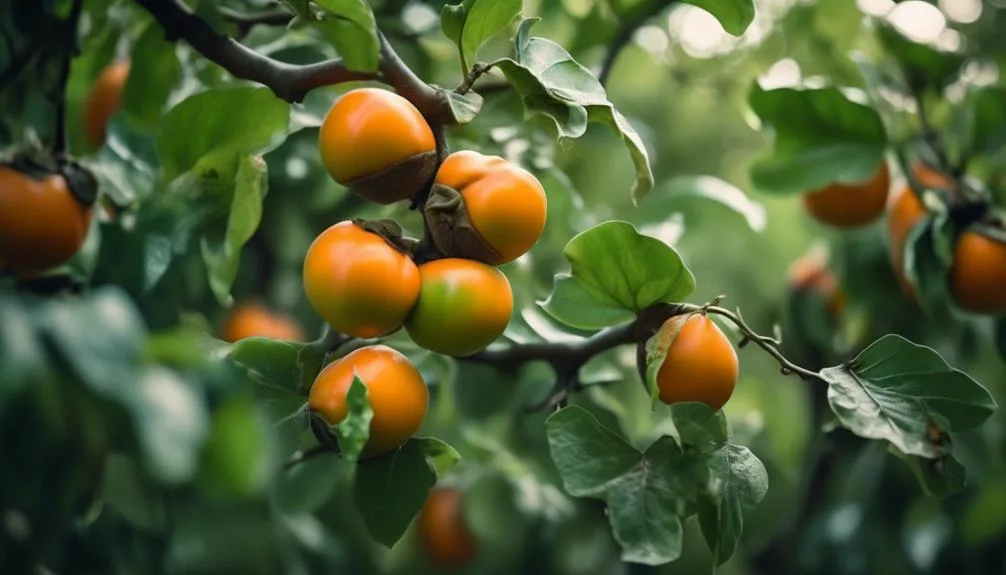If you've seen weird spots on your persimmon tree leaves or noticed the fruit starting to rot, it could be due to common persimmon tree diseases. But don't worry, there are ways to deal with these issues.
By spotting the symptoms and taking preventative steps, you can fight these diseases and keep your trees healthy. Let's look at some strategies to protect your persimmon trees and ensure a good harvest.
Key Takeaways
- Early detection and treatment of persimmon tree diseases is crucial for effective management.
- Proper irrigation and air circulation are important preventive measures to reduce the risk of diseases.
- Regular inspection of trees for signs of disease or pest infestations is essential.
- Natural remedies, such as neem oil and disease-resistant varieties, can be used to control diseases and pests.
Identifying Common Persimmon Tree Diseases
To identify common persimmon tree diseases, you can start by examining the leaves and fruit for any unusual discoloration or spots. Proper tree health and disease prevention are essential for the overall well-being of your persimmon trees. Keep an eye out for signs of fungal infections such as leaf spot, which presents as small, dark spots on the leaves that can merge and cause defoliation.
Another common disease is powdery mildew, which appears as a white powdery substance on the leaves and fruit. Regularly inspecting your trees for these symptoms is crucial for early detection and treatment.
Additionally, ensuring proper irrigation and good air circulation around the trees can help prevent the onset of these diseases. By being proactive in identifying and addressing these issues, you can maintain the health of your persimmon trees.
Preventative Measures for Persimmon Tree Diseases
Ensuring proper irrigation and good air circulation around your persimmon trees is essential for preventing the onset of diseases. By implementing the following preventative measures, you can maintain the health of your persimmon trees:
- Soil management: Regularly test the soil pH and nutrient levels to ensure it meets the specific requirements of persimmon trees.
- Pruning techniques: Prune your persimmon trees carefully to promote good air circulation and reduce the risk of fungal diseases. Remove any dead or diseased branches to prevent the spread of infections.
- Mulching: Apply a layer of organic mulch around the base of the tree to retain moisture, regulate soil temperature, and suppress weed growth.
- Regular inspections: Monitor your persimmon trees for any signs of disease or pest infestations, and take prompt action if any issues are detected.
Natural Remedies for Persimmon Tree Diseases
Maintaining the health of your persimmon trees through proper soil management, pruning, mulching, and regular inspections sets the foundation for addressing any potential diseases with natural remedies.
When it comes to natural remedies for persimmon tree diseases, organic solutions play a crucial role in combating common issues. Neem oil, for example, can help control pests and fungal infections.
Additionally, disease-resistant varieties such as the Hachiya and Fuyu persimmons are less susceptible to certain diseases, offering a natural defense mechanism. Introducing beneficial insects like ladybugs and lacewings can also aid in controlling harmful pests without the use of chemical pesticides.
Chemical Treatments for Persimmon Tree Diseases
Combatting persimmon tree diseases often requires the use of chemical treatments to effectively eradicate stubborn infections and protect the overall health of the trees. When it comes to chemical treatments for persimmon tree diseases, there are several options to consider for disease prevention and control:
- Fungicide application: Select a suitable fungicide to treat common fungal diseases such as leaf spot and powdery mildew. Follow the manufacturer's instructions for application and safety precautions.
- Timing of application: Apply fungicides during the appropriate times of the year to coincide with the life cycle of the pathogens causing the diseases.
- Systemic treatments: Consider using systemic fungicides that are absorbed by the tree and provide longer-lasting protection against diseases.
- Consultation: If you're unsure about the appropriate chemical treatments, seek advice from a professional arborist or horticulturist.
Maintenance and Care for Healthy Persimmon Trees
To keep your persimmon trees healthy, regular and thorough maintenance is essential. When it comes to pruning techniques, focus on removing dead or diseased branches to promote airflow and reduce the risk of infection. Additionally, prune your trees in late winter to early spring to encourage new growth.
As for fertilization methods, consider using a balanced fertilizer in early spring before the trees start to bloom. This will provide essential nutrients for healthy growth and fruit production. Avoid overfertilizing, as it can lead to excessive foliage at the expense of fruit development.
Conclusion
In order to keep your persimmon trees healthy and productive, it's important to remain vigilant for signs of disease. Take preventative measures and treat any issues promptly. By staying proactive and attentive, you can help your trees thrive and continue to yield delicious fruit for years to come.
Remember, regular maintenance and swift action are key to ensuring the long-term health of your persimmon trees.

